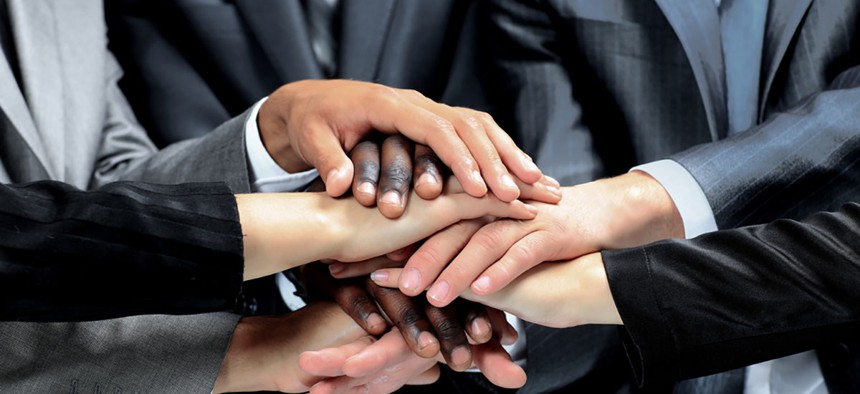
EDHAR/Shutterstock.com
The Weakening Definition of 'Diversity'
Millennials think that diversity is less about race and gender than it is about different “experiences.” What does this mean for America?
What qualifies as a “diverse” workplace? Does it mean that employees are of a variety of different races and genders? Or does it mean they’ve had a variety of life experiences?
Millennials seem to be tilting toward that latter, more easily attainable vision. Arecent study from Deloitte and the Billie Jean King Leadership Initiative, found that when it comes to defining diversity, rather than focusing on demographic features, such as race, or gender, Millennials—those born roughly between 1980 and 2000—are more concerned with hiring those who may have different cognitive viewpoints due to growing up in a different part of the country, or attending a different type of school. Differences in race or gender can play a role in those differing viewpoints, but they may not be singled out as important diversifying characteristics. “Diversity means to me your background based on your previous work experience, where you were born and raised, and any unique factors that contribute to your personality and behavior,” said one Millennial who was surveyed.
This is a departure from what older generations understand diversity to mean. “Millennials frame diversity as a means to a business outcome, which is in stark contrast to older generations that view diversity through the lens of morality (the right thing to do), compliance, and equality,” the study of more than 3,700 individuals spanning different generations, races, and genders found. According to Christie Smith, one of the study’s authors, this generation is already comfortable with the idea of diversity in a traditional sense and they’re looking to expand the definition, which could be a good thing.
It could also be troubling, says Adia Harvey Wingfield, an assistant professor of sociology at Georgia State University who studies issues of race, class, and gender and their impacts in the workplace. “Diversity becomes defined so broadly that using diversity programs or affirmative action as a way of remedying ongoing historical inequalities can easily become overlooked and dismissed,” she said. “People become focused on having diversity for the sake of diversity and it loses the power to addresses existing inequalities.”
The idea and importance of cognitive diversity is nothing new. A 2004 studyfrom researchers at the University of Michigan and Loyola Chicago found that creating groups of individuals who had diverse approaches to problem solving outperformed groups that were made up of only the most talented problem-solvers. And a 2012 study from McKinsey found that increased representational diversity could help a company’s bottom line, supporting the idea that outside of morality or justice, diversity may be helpful simply as a business strategy.
But this type of viewpoint may harm groups traditionally helped by diversity initiatives, and nod to a skewed view of society’s progress, says Wingfield. When it comes to the workplace there are many professions where racial, ethnic, and gender diversity are still hard to come by. In 2013, only 4 percent of U.S. physicians were black. According to 2012 research, Hispanics made up only about 3.7 percent of licensed lawyers, according to the American Bar Association. Asians accounted for only 3.4 percent of all lawyers. And we’ve all heard the narrative about the lack of gender diversity in STEM fields, where women made up only 26 percent of the workforce in 2011. “If we're not focusing on diversity to address all parts of our society by including those who have been historically most disenfranchised,” she said, “then a broad type of diversity doesn't really serve us well.”
Millennials are the most diverse group of young adults the nation has seen. And for some, that may mean that the idea of diversity, at least when it comes to race and ethnicity, feels like a given. Though inequalities that have existed for generations persist, some Millennials might think of them as less of a problem. But research, and current events, would show that may not be the case. “We live in a more diverse world in a superficial sense,” Wingfield says. “When we think about where we live, where we go to school, where we work, that type of diversity hasn't really happened yet.” That creates a gap between perception and reality she says. “Millennials have this reputation for having adopted this more progressive, forward-thinking viewpoint—at the same time, a lot of the institutions that structure their lives really haven't changed so much.”
And a 2014 study from the Public Religion Research Institute confirms that, finding that when it comes to social groups, most young Americans still tend to stick with those who are most like them. White Americans said that 91 percent of their social network was also white. For black Americans, about 83 percent of their social network was made up of other black Americans. Hispanics were found to have the most diverse peer groups, reporting that only 64 percent of their social group was made up of other Hispanic Americans, according to the study.
Wingfield stresses that while looking at diversity of thought is great—important even—it shouldn’t overshadow or decrease diversity efforts that take historic disadvantage into account. She says that such considerations that could help bring Americans together to create true diversity are critical, especially as the population of the country becomes more diverse, “Many aspects of our lives still remain pretty rigidly segregated in ways that have got to change,” she said. “We can't afford to continue the way that we have been.”
(Image via EDHAR/Shutterstock.com)
NEXT STORY: Nobody Trusts Barack Obama on Energy






